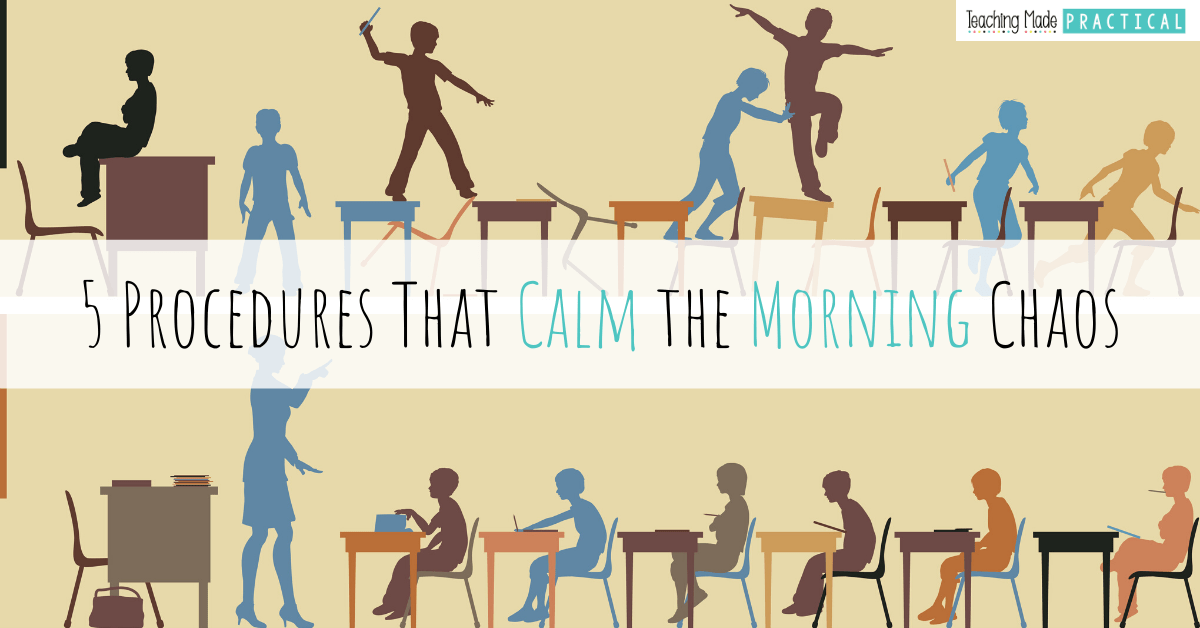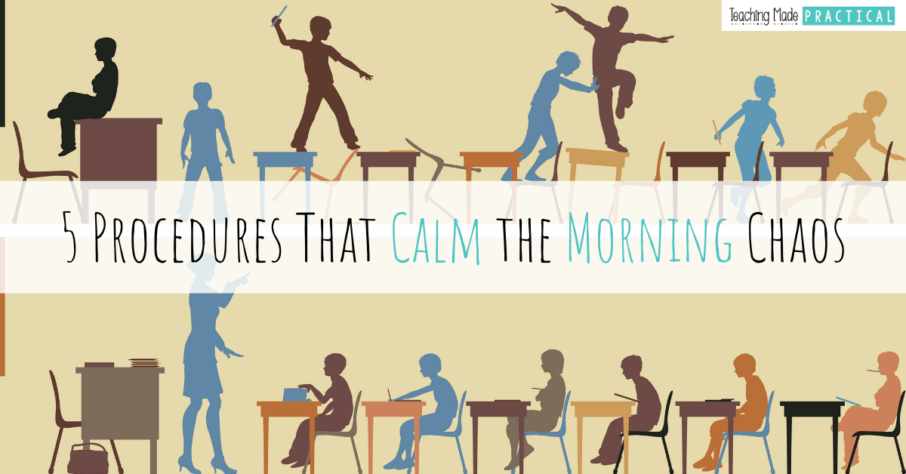
For me, having well thought out morning procedures is absolutely crucial to my survival in an upper elementary classroom. Not only does the classroom morning routine set the tone for the day, but it is also the best time of day to do all those annoying but necessary tasks like sharpening pencils and turning in field trip forms.
It's also one of the craziest times of day (other than after recess and dismissal). The morning time is when everybody wants your undivided attention.
Your students want to tell you about their baseball game or dance practice last night. Their parents want to explain to you while their child didn't get a chance to do their homework the night before (because of the baseball game or dance practice). Administrators drop in to give you heads up about the new student you will be getting in about 2 minutes. And while everyone wants to talk to you, you're wondering when you're going to get a chance to make copies for a math activity later that day.
Needless to say, your life will be a lot easier if your morning routine runs like a well-oiled machine (even if that machine is chatty, inquisitive, and sometimes a little bit smelly).
Setting Up Your Classroom Morning Routine
There's not one "best" way to set up your classroom morning procedures - in fact, every upper elementary classroom morning routine is going to look a little different. However, I've found that most successful arrival procedures include some version of the following:
- Greeting Students
- Having Students Turn in Homework and Other Papers
- Having Students Organize and Prepare for the Day
- Taking Attendance
- Having Students Begin Morning Work
You might not want to include all of these tasks, or you might want to add a few of your own. The important thing is that you plan out your morning routine before hand. Otherwise, students will create their own procedures.
1. Greet Students
This is usually your first interaction with your students in the morning, so it is important that it is a positive one. Taking the time to greet each of your students can be time consuming, but it can make a big difference.
Here's how I made sure to greet each of my students every morning.
However you plan on greeting your 3rd, 4th, and 5th grade students in the morning, making an effort to greet each student individually (even it it just a smile) can really help you day start off on the right foot.
2. Have Students Turn in Homework and Other Papers
With all of the other distractions, turning in important papers and homework is often the first thing to get neglected.
My brother was absolutely TERRIBLE at turning in his homework. He always completed it - my mom made sure of that - but he never remembered to turn it in.
I remember my mom being absolutely horrified one night after opening my brother's backpack and finding almost 2 months of homework. When she asked my brother about it, his excuse was that he "didn't know where to turn it in."
This was a pretty pathetic excuse on my brother's part, but it is important to make sure all your students know exactly where to turn in homework and other important papers.
At the beginning of the year, I would always have my students point to our "turn in trays" as we practiced our morning procedures, even though they didn't have anything to turn in. By making it a habit from the first day of school, you will have fewer problems later.
Fun, No Prep Halloween ELA Activities! Includes:
- Halloween Fun Packet
- History of Halloween Reading Passage
- Monster Descriptive Writing Activity
- Spooky Figurative Language
- Bats Reading Comprehension and Snowball Fight
3. Have Students Organize and Prepare for the Day
This is the part of the morning arrival procedures where you have students complete all of the tasks you don't want to be interrupted with later on in the day. This can include things like having students:
- sharpen pencils
- unpack backpacks
- hang up backpacks
- put lunches in a basket
- put library books away
- choose books to read from the classroom library
- unstack chairs
- write in agendas
- fill up water bottles
- prepare for a classroom job
Different teachers will want different things completed during this time. Whatever you want your students to do in the morning, make sure you are very clear about your expectations.
If you are expecting your students to do several things, it might help to post a list of all of the tasks to help remind students about what they are supposed to do.
By using this time wisely, you will have less interruptions later on and more time for actual learning.
4. Take Attendance and Lunch Count
My first year teaching, it was embarrassing how many times I forgot to take attendance. Fortunately, my school secretary was the sweetest lady in the world and never seemed aggravated when she had to call me to remind me to take attendance (like she didn't already have enough to do...)!
Part of the reason I constantly forgot to take attendance was that I was simply using the "glance around the room and see who's missing" method. Once I started making students more accountable, I rarely forgot.
There are a variety of charts and fun ways to take attendance. A quick Google search or Pinterest search will give you a huge variety of options.
Since I used ClassDojo as classroom management tool, I also had students use it to take attendance. They would simply touch their avatar on the Smartboard to let me know they were here. One quick glance and I could see who was out.
Also, one of my classroom jobs was a "reminder monitor." This person was responsible for reminding me of all sorts of things that I was consistently forgetting to do - including taking attendance. See more about how I set up classroom jobs to make my life easier here.
The vast majority of my students were on free lunch, so lunch count was not very complicated in my classroom. If you are looking for ideas on lunch count procedures, check out this post by Tale of a 4th Grade Math Nut.
5. Have Students Begin Morning Work
When deciding what kind of morning work you want your students to complete, there are a lot of factors to consider. Will students be able to complete it independently? Will they need help? Will they finish it too quickly?
Prioritizing morning work that students can complete independently and that will keep students busy will make it easier for you to complete other tasks. Check out these 14 morning work ideas if you aren't sure what you want to do in your classroom.
Or, if you are a 3rd grade teacher, this free two weeks of math morning work might be helpful.
Whatever you decide to do, make sure it is easy and requires very little planning on your part - save your time and energy for planning your lessons.
Practice Your Classroom Morning Routine...and Practice Again
However you decide to set up your classroom morning routine, the most important thing is that you have a plan before the first day of school so that you can have your students practice.
3rd, 4th, and 5th grade students will need practice, practice, and more practice. But the practice will eventually pay off.
Side note: This procedures checklist will help you figure out what other procedures you might want to have a plan for.
These ideas for reviewing classroom procedures can help you practice your morning routine over and over again without boring your students.
Looking for more classroom management ideas? You're in luck.
Or, are you trying to decide what activities or ice breakers you want to do when you head back to school? Check out these ideas.
Never Stress Over Sub Plans Again!

Make copies, find a fiction book, and you'll be ready for any emergency that comes your way!


